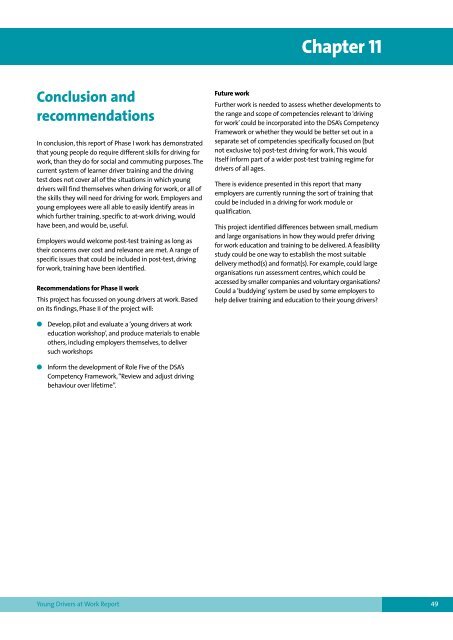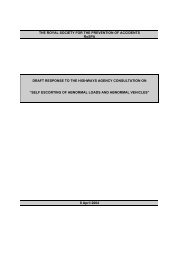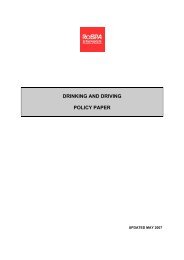RoSPA Young Drivers at Work Report
RoSPA Young Drivers at Work Report
RoSPA Young Drivers at Work Report
You also want an ePaper? Increase the reach of your titles
YUMPU automatically turns print PDFs into web optimized ePapers that Google loves.
Chapter 11<br />
Conclusion and<br />
recommend<strong>at</strong>ions<br />
In conclusion, this report of Phase I work has demonstr<strong>at</strong>ed<br />
th<strong>at</strong> young people do require different skills for driving for<br />
work, than they do for social and commuting purposes. The<br />
current system of learner driver training and the driving<br />
test does not cover all of the situ<strong>at</strong>ions in which young<br />
drivers will find themselves when driving for work, or all of<br />
the skills they will need for driving for work. Employers and<br />
young employees were all able to easily identify areas in<br />
which further training, specific to <strong>at</strong>-work driving, would<br />
have been, and would be, useful.<br />
Employers would welcome post-test training as long as<br />
their concerns over cost and relevance are met. A range of<br />
specific issues th<strong>at</strong> could be included in post-test, driving<br />
for work, training have been identified.<br />
Recommend<strong>at</strong>ions for Phase II work<br />
This project has focussed on young drivers <strong>at</strong> work. Based<br />
on its findings, Phase II of the project will:<br />
Future work<br />
Further work is needed to assess whether developments to<br />
the range and scope of competencies relevant to ‘driving<br />
for work’ could be incorpor<strong>at</strong>ed into the DSA’s Competency<br />
Framework or whether they would be better set out in a<br />
separ<strong>at</strong>e set of competencies specifically focused on (but<br />
not exclusive to) post-test driving for work. This would<br />
itself inform part of a wider post-test training regime for<br />
drivers of all ages.<br />
There is evidence presented in this report th<strong>at</strong> many<br />
employers are currently running the sort of training th<strong>at</strong><br />
could be included in a driving for work module or<br />
qualific<strong>at</strong>ion.<br />
This project identified differences between small, medium<br />
and large organis<strong>at</strong>ions in how they would prefer driving<br />
for work educ<strong>at</strong>ion and training to be delivered. A feasibility<br />
study could be one way to establish the most suitable<br />
delivery method(s) and form<strong>at</strong>(s). For example, could large<br />
organis<strong>at</strong>ions run assessment centres, which could be<br />
accessed by smaller companies and voluntary organis<strong>at</strong>ions?<br />
Could a ‘buddying’ system be used by some employers to<br />
help deliver training and educ<strong>at</strong>ion to their young drivers?<br />
●<br />
●<br />
Develop, pilot and evalu<strong>at</strong>e a ‘young drivers <strong>at</strong> work<br />
educ<strong>at</strong>ion workshop’, and produce m<strong>at</strong>erials to enable<br />
others, including employers themselves, to deliver<br />
such workshops<br />
Inform the development of Role Five of the DSA’s<br />
Competency Framework,“Review and adjust driving<br />
behaviour over lifetime”.<br />
<strong>Young</strong> <strong>Drivers</strong> <strong>at</strong> <strong>Work</strong> <strong>Report</strong><br />
49
















